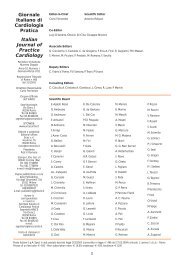Scarica il documento in formato pdf (556 KB) - ANCE
Scarica il documento in formato pdf (556 KB) - ANCE
Scarica il documento in formato pdf (556 KB) - ANCE
You also want an ePaper? Increase the reach of your titles
YUMPU automatically turns print PDFs into web optimized ePapers that Google loves.
Editorial<br />
A new therapy?<br />
C. Fernandez<br />
There is a progressively <strong>in</strong>creas<strong>in</strong>g contrast between the exaggerated speed of the current technological evolution<br />
– which leads us to believe <strong>in</strong> the existence of new, more or less radical solutions to everyth<strong>in</strong>g, even to the<br />
“disease” problem -, and the apparently static proposal put forth by Wald and Law (1), based on the attempt to<br />
prevent both cardiovascular pathologies and contracted diseases by resort<strong>in</strong>g – albeit <strong>in</strong> different manners – to<br />
the knowledge and sk<strong>il</strong>ls we already possess and da<strong>il</strong>y apply on thousands of patients.<br />
This article cannot and is not meant to discuss the deta<strong>il</strong>s of the above mentioned proposal: we only emphasise<br />
that it suggests anticipat<strong>in</strong>g and stimulat<strong>in</strong>g elements which could – <strong>in</strong> the near future – br<strong>in</strong>g about a revolution<br />
<strong>in</strong> our way of th<strong>in</strong>k<strong>in</strong>g and, consequently, of act<strong>in</strong>g.<br />
It is now many years that the scientific progress <strong>in</strong> the medical field has been constra<strong>in</strong>ed <strong>in</strong>to very rigid rational<br />
patterns, impos<strong>in</strong>g the requirement to produce def<strong>in</strong>ite and cont<strong>in</strong>uous evidence concern<strong>in</strong>g: 1) the diagnostic<br />
capab<strong>il</strong>ities; 2) the validity of performable operations; and 3) the effectiveness of pharmacological treatments.<br />
It is likely that the limits which we are not able to surpass - such as those connected with the onset of the major<br />
diseases (i.e. cardiovascular and neoplastic diseases) especially <strong>in</strong> the Western countries where research is particularly<br />
advanced – are the very limits which seem <strong>in</strong>surmountable at the moment and have somehow clipped<br />
the w<strong>in</strong>gs of any theory parallel to science, forc<strong>in</strong>g us to th<strong>in</strong>k only with<strong>in</strong> the conventional tracks.<br />
In recent years, no new approaches have been suggested, but for the genetic assumptions, which aroused some<br />
concerns <strong>in</strong> the researches, especially l<strong>in</strong>ked to the fact that – <strong>in</strong>itially at least – it would be very difficult to<br />
contrast the anomalies responsible for the onset of pathologies and, consequently, of diseases.<br />
However, at the time be<strong>in</strong>g, we tend to treat any pathological event by adm<strong>in</strong>ister<strong>in</strong>g drugs and/or surgery, with<br />
or without the fitt<strong>in</strong>g of a prosthesis: to hypothesise a new, dom<strong>in</strong>ant factor unconnected with the traditional cause-effect<br />
model could cause the collapse of the very certa<strong>in</strong>ties to which we have always clung and on which<br />
we based all our scientific researches and/or “conquests” up to now. Also this framework conta<strong>in</strong>s new, “revolutionary,”<br />
generally unclear and destab<strong>il</strong>is<strong>in</strong>g elements.<br />
Actually, the adoption of such a certa<strong>in</strong>ty model <strong>in</strong> the past 50 years has driven away any “revolutionary” assumption,<br />
thus br<strong>in</strong>g<strong>in</strong>g serenity and a solid basis to the scientific world, with far-reach<strong>in</strong>g repercussions even at<br />
the socio-economic and <strong>in</strong>dustrial level.<br />
The proposal of Wald and Law (1) - revolutionary <strong>in</strong> a certa<strong>in</strong> way -, conta<strong>in</strong>s sim<strong>il</strong>ar destab<strong>il</strong>is<strong>in</strong>g elements, both <strong>in</strong> the<br />
moral and <strong>in</strong> the economic context, and could push us to re-exam<strong>in</strong>e the cause-effect model, <strong>in</strong>directly lead<strong>in</strong>g us to<br />
put up new forms of defence, thus completely chang<strong>in</strong>g the medical approach to alleged or contracted diseases.<br />
I do not th<strong>in</strong>k that we should presumptively reject this proposal, but rather, also due to its <strong>in</strong>novative features,<br />
that we should carefully analyse and exam<strong>in</strong>e it, hop<strong>in</strong>g that it w<strong>il</strong>l prevent us from consider<strong>in</strong>g our patients as<br />
a homogeneous mass of <strong>in</strong>dividuals to be treated sic et simpliciter, and to always remember that the patient<br />
who turns to us, com<strong>in</strong>g <strong>in</strong>to our office for help to overcome “his/her” disease, is a special human be<strong>in</strong>g.<br />
REFERENCES<br />
1. A strategy to reduce cardiovascular disease by more than 80%. N J Wald, M R Law. BMJ 2003;326,1419-24.<br />
5
















